Here, we have a list of the best things to do and what to see on your trip to Cluj-Napoca. We’ve got suggestions for what to see when you are wandering around the city center as well as those who want to venture out to the forest.
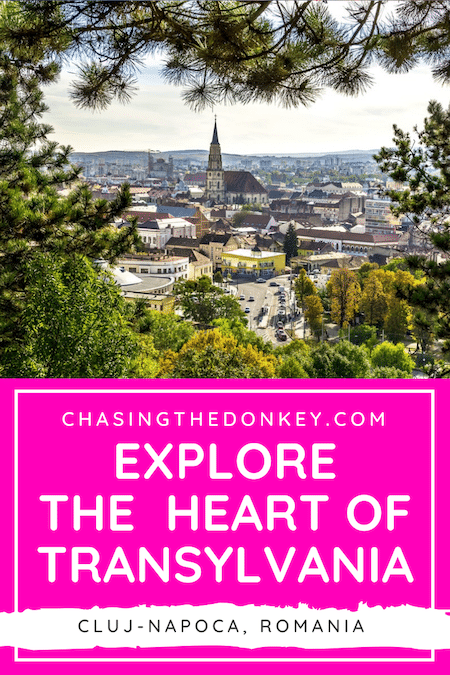
Skip Ahead To My Advice Here!
Visiting Cluj-Napoca
Cluj-Napoca is the unofficial capital of Transylvania, a region known for its spooky Dracula legends, beautiful landscapes, and rich heritage. As the second-biggest city in Romania, visiting Cluj-Napoca is an essential part of any Romania itinerary.
Once the heart of the Transylvania region, Cluj-Napoca has now transformed itself into a charming city with vibrant nightlife (partly thanks to the several universities in town). However, dotting the idyllic streets are still many historic buildings that tell the tales of its long history.
That is why we have written this post to showcase some of the best things to do in Cluj-Napoca so that you can discover the best of Cluj on your visit!
Best Things To Do In Cluj-Napoca: Top Attraction Ideas
We’ve made a list of the top attractions in Cluj-Napoca, Romania, for you!
1. Explore Hoia-Baciu, One Of The Most Haunted Forests In The World
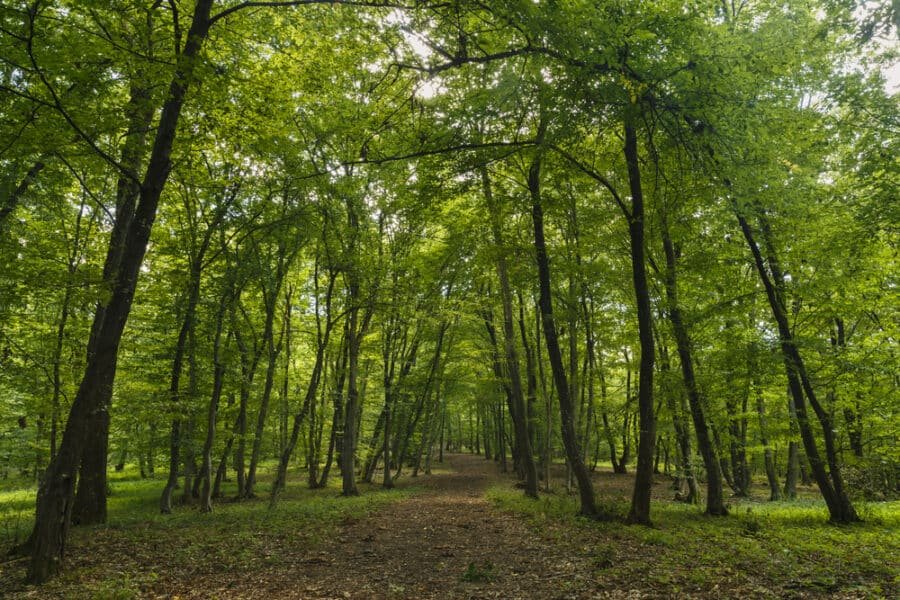
Hoia-Baciu is one of the biggest attractions in Cluj-Napoca, but it has nothing to do with Cluj’s history. Hoia-Baciu earned its fame by being one of the most haunted forests in the world. Paranormal activities are rumored to occur there regularly, and many documentaries feature Hoia-Baciu.
Some call it the “Bermuda Triangle of Transylvania” or “Romania’s Most Haunted Forest.” Others refer to it as a mysterious natural wonder.
Many features of the Hoia-Baciu forest make it so strange. First of all, none of the trees grow straight inside, but rather in a peculiar twisted shape. To this day, scientists don’t know why they grow in this shape and pattern.
Secondly, the Hoai-Baciu is a dense forest, except for one oval-shaped area known as “The Circle” or “The Clearing,” where no vegetation grows. Scientists have researched the soil here and found no discrepancy between the soil quality from The Circle from the rest of the forest.
There are rumors of people disappearing from Hoia-Baciu, unexplained lights, UFO sightings and mysterious shadows. However, this doesn’t stop tourists from visiting this forest, and interested visitors can find daytime and nighttime tours to Hoia-Baciu from Cluj.
If you’re planning to visit Hoia Baciu, prepare for an adventure that’s both thrilling and eerie. The forest is easy to access from Cluj, making it a popular destination for both locals and tourists. As you step into the woods, you’ll be greeted by dense vegetation and a sense of being in a place where the ordinary rules might not apply.
While the forest’s reputation for the supernatural might pique your curiosity, taking precautions is essential. Always visit during daylight hours, and let someone know about your plans. Stick to marked trails and avoid wandering off the beaten path.
2. Admire Transylvanian Architecture At Saint Michael Church
Also known as Biserica Sf. Mihail, this church is a stunning example of Transylvanian architecture while being rather beautiful at the same time. You’ll see pictures of St. Michael’s church in literature promoting Cluj-Napoca for tourism.
Be sure to check out the beautiful interior and the church tower, which soars for 80 meters.
3. Take A Peaceful Stroll Through Cluj’s Central Park
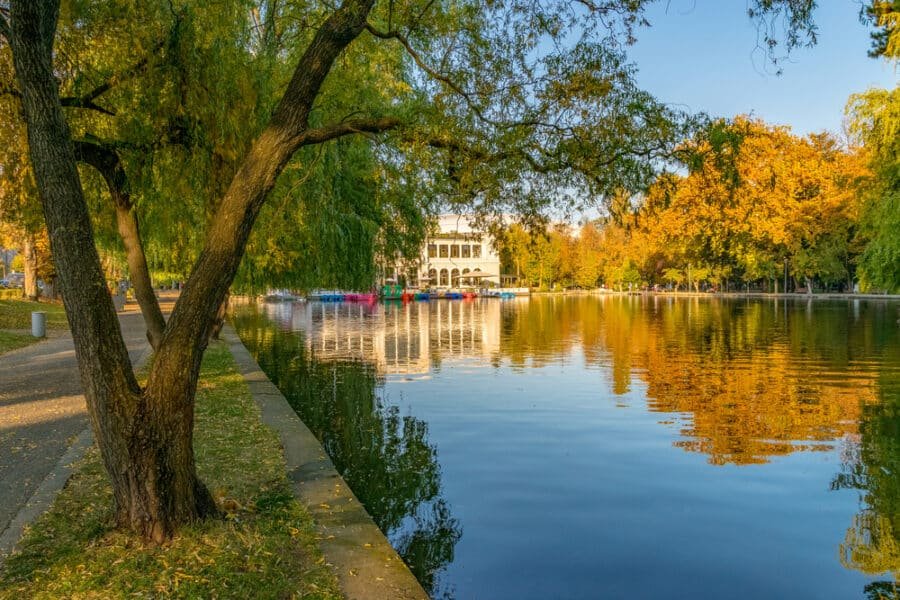
Situated in the historical center of Cluj is Cluj’s biggest public park, the Cluj Central Park. Founded in 1827, Cluj Central Park has served as a prime recreational space for all the residents of Cluj since then. The lush park is perfect for a relaxing evening stroll, allowing guests to reconnect with nature without having to go far briefly, one of those simple yet super-enjoyable Cluj-Napoca activities.
The Central Park of Cluj is often filled with beautiful plants and flowers, but those are far from its greatest attraction. Situated inside the Central Park is a small pond where visitors can ride a hydro bike and paddle across. On the pond’s perimeter, guests will find cafes and restaurants where they can enjoy some delicious refreshments and admire the peaceful views.
The historic Casino is also situated in Central Park of Cluj. Once the perfect place for gamblers, it is now a place for art exhibitions and ceremonial purposes. If you are looking for a relaxing afternoon in the city, Central Park is one of Cluj’s best places to visit.
4. Immerse Yourself In Art At The Cluj-Napoca Art Museum
Art and architecture fans should definitely head to this museum as it’s a wonderful blend of both. The building dates back to the 18th century and is designed in baroque style. It’s also very easy to reach, as it’s right in the center of the city.
Inside, you’ll find paintings and decorative art by famous artists, including Grigorescu, Luchian, and Paciurea, to name a few.
5. Discover Unirii Square (Union Square), The Biggest Square In Cluj
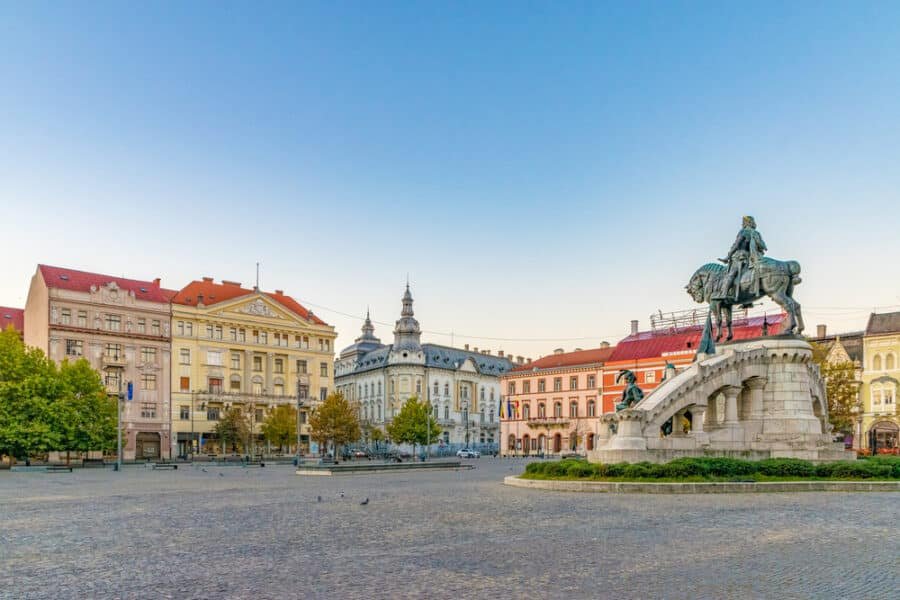
The most crucial feature of Cluj’s historic center is Unirii Square, the largest square in Cluj-Napoca. Union Square contains some of the most historical Cluj-Napoca attractions, such as the Roman Catholic St. Michael’s Church and the statue of Matthias Corvinus, King of Hungary, from 1458 to 1490.
If you don’t have a tour guide with you, you might not grasp Unirii Square’s historical significance. That is why it is important to have a tour guide for this part of Cluj, and there are many walking tours around the city at your service. If you are exploring Cluj without a tour guide, you can still enjoy some of Unirii Square’s biggest attractions, such as checking out St. Michael’s Church.
At 50 meters wide (at the nave) and 80 meters high, St. Michael’s Church is the second biggest church in Transylvania (just after the Black Church in Brasov). The tower sits 80 meters high (including the 4-meter high cross) and is the highest in Transylvania. On the exterior, the masterful Gothic architecture looms over the Unirii Square, casting its beauty on anyone that passes by.
Exploring the inside of St. Michael’s Church is a must (and free). Visitors will find gorgeous stained glass and numerous artworks in the interior of this architectural masterpiece. When visiting, don’t miss the chance to go up to the church tower, where you will find a stunning bird’s-eye view of the city.
So, if you’re wondering what to see in Cluj-Napoca, we suggest starting at this landmark-dotted square.
6. Understand The Past At The National Museum Of Transylvanian History
Everyone is fascinated with the Transylvanian area, and this museum tells you about it in one easy-to-visit place. There are more than 400,000 artifacts to explore, dating back thousands of years. There are also temporary exhibits from time to time.
The National Museum of Transylvanian History is highly regarded as a European institution, so it’s a spot you should place on your visit list.
7. Learn Romanian Heritage At the Ethnographic Museum Of Transylvania
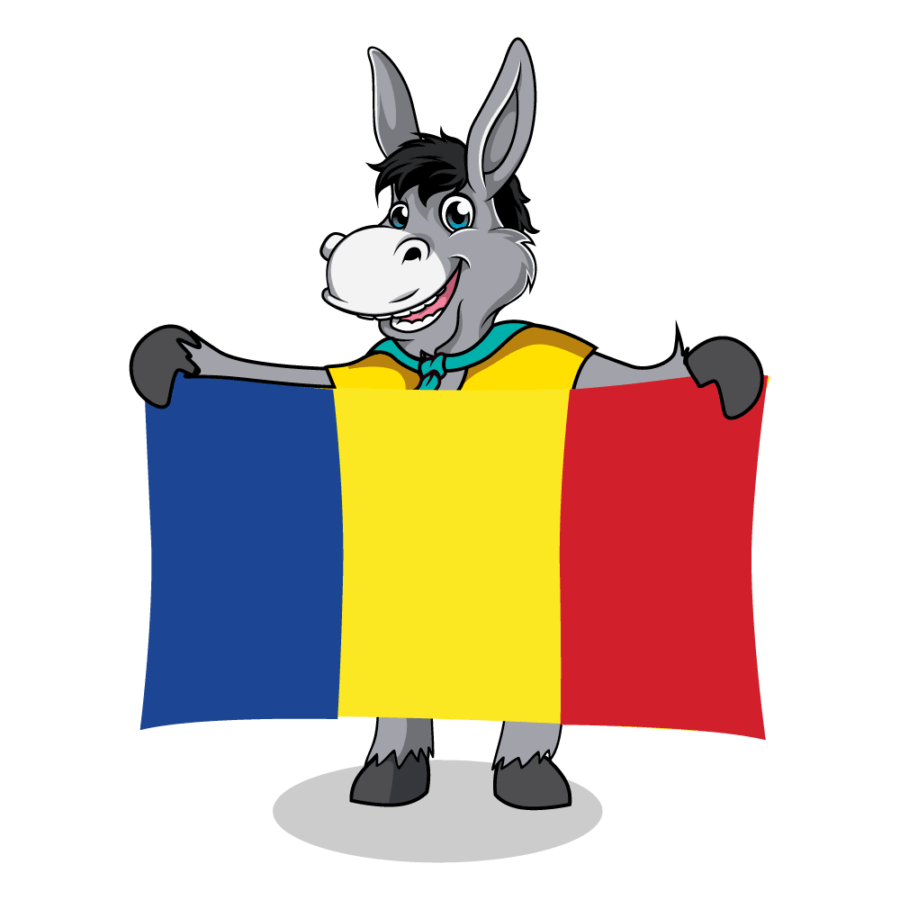
As the capital of the Transylvania region, Cluj-Napoca is the ideal place to learn about its heritage. There is no better place in the city to do so than the Ethnographic Museum of Transylvania.
The Ethnographic Museum of Transylvania consists of two exhibitions: the indoor museum in the historical center of Cluj and the outdoor open-air museum located 10 minutes away. Both are among the greatest Cluj tourist attractions and come highly recommended.
The indoor exhibition is located in Palais de la Redoute. Visitors will find a huge collection of items used throughout Romanian rural life’s history. The collection includes clothes, tools, photos, and a wide selection of scholarly journals and magazines.
The second part of the museum is located about a 10-minute drive (or 40-minute walk) from the Piața Unirii. Known as the Ethnographic Park Romulus Vuia, it is the first open-air museum in Romania. Most objects date back hundreds of years, with the oldest dating to 1678.
In the wide-open space, visitors will find many traditional Transylvania elements, such as old farms, mills, workshops, churches, and various buildings from different parts of Transylvania. Though visitors are not allowed to enter the buildings, just seeing them from the outside and getting close to them is like you have stepped into a time machine! It’s one of those uniquely cool places in Romania.
8. Head Inside Tailors’ Tower
Tailors’ Tower is part of the old fortress, and back in the 15th century, it was funded by the tailors’ guild to defend the city against invaders. Inside, you’ll find a museum to learn more about the area and the tower itself, but it’s a pretty impressive spot and one of the oldest towers.
9. Check Out The Amazing Hilltop Views From Cetatuia Park
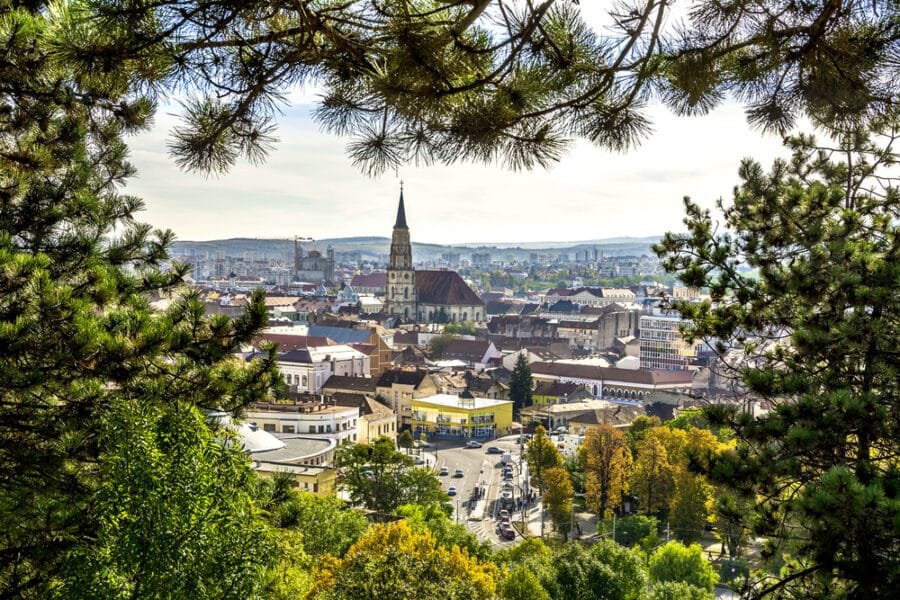
Located across the Someșul Mic River, away from the Old Town of Cluj, is another one of the city’s pristine parks: the Cetatuia Park. A popular destination on Cluj sightseeing excursions, the Cetatuia Park is perched over the hill and offers visitors panoramic views of the city and the surrounding landscape from above.
Lights from every crevice of Cluj illuminate to offer visitors a unique view of Cluj. Its wide-open spaces are particularly ideal for photographers, as they can photograph Cluj from many different angles. Though the views in the daytime are gorgeous, the night views are more sought after. It is no wonder why you will still find plenty of people in Cetatuia Park at night.
In the daytime, locals love to hang out in the Cetatuia Park for some fresh air, walk along the short hiking trails, and enjoy some of the excellent restaurants inside the park.
10. Gather With The Locals At The Statue Of Matthias Corvinus
Matthias Corvinus was a Hungarian king between 1458 and 1490. He was also a Cluj native, having been born there in 1443. The statue was built to commemorate his reign, and you can also head to Hunedoara Castle if you want to learn more, as he was the second son of one of the kings there. Incidentally, the castle is one of the largest in the region.
The land around the statue itself is well worth a visit as it’s a calm and relaxing spot where many locals gather.
11. Take A Day Trip To Salina Turda Salt Mine
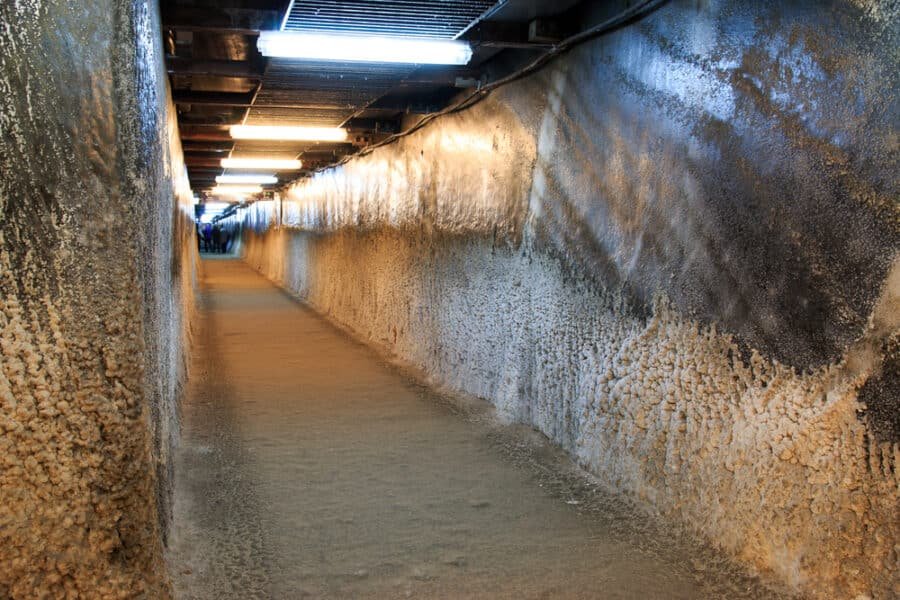
Salina Turda is genuinely one of the hidden gems of Cluj Napoca. It is one of the best hidden gems in the entire world. Business Insider has personally ranked Salina Turda as one of the “25 hidden gems across the world that are worth the trek.”
Salina Turda is one of the oldest salt mines in the world. First mentioned in 1075, the Turda Salt Mine remained operational until 1932. Nowadays, you won’t get any salt production here; however you will find that this ancient salt mine has two main reasons to visit.
First, its underground galleries and large, high-ceiling caverns host an unusual amusement park.
Inside the Rudolf Hall of the Salina Turda, you will find bowling alleys, ping pong tables, billiards, theaters, mini-golf courts, and more entertainment to keep everyone in the family entertained. However, that isn’t all. Its most iconic feature is the 20-meter-tall Ferris wheel that makes you question, “How did they get that thing in here?”
Descend from Rudolf Hall into the Theresa Mine, and you will find the 6-meter deep underground lake. Visitors can rent a boat and row it around for 20 lei, taking in the gorgeous views and health-enhancing salty air.
Visitors will also enjoy the artificial lighting installations. Everything was designed to highlight the salt mine’s natural beauty and artificial galleries and give visitors a magical experience.
Second – well known among Romanians but less so by foreign tourists – is that inhaling salty air is good for your lungs and treats respiratory diseases. This is something even the Romans knew! Romanian doctors regularly prescribe salty air therapies and Turda Salt Mine, along with other salt mines such as Praid or Ocnele Mari, is a preferred destination for this.
What do you have to do to get these health benefits? Nothing! Just spend 2-4 hours in the mine. Take a tour to learn about its salt exploitation history and the interesting tools used, play some games or bring a book with you. Beware, though, as no food or drinks (other than still water) are allowed inside the mine as they will interfere with the air!
Salina Turda, is located about 45 minutes from Cluj-Napoca by car, making it an excellent day trip. If you haven’t rented your own vehicle, taking a taxi or an organized tour is recommended to get there. This is a fantastic excursion if you’re spending a weekend in Cluj.
12. Visit The Assumption Cathedral, AKA Dormition Of The Theotokos Cathedral
The Assumption Cathedral (also known as Dormition of The Theotokos Cathedral) is a beautiful Romanian Orthodox Cathedral located in the heart of Cluj-Napoca. Constructed between 1923 and 1933, the cathedral is built in a Romanian Brâncovenesc style, combining Renaissance and Byzantine architecture.
Visitors can admire the 64-meter-high structure at the Avram Iancu Square. They will also find the National Theater and a statue of Avram Iancu, a prominent figure in the Austrian Empire Revolutions.
When you are done admiring its eight towers and four bells from afar, make sure you visit inside. Though the exterior is the most stunning part of this structure, the interior is far from lackluster. It is also completely free to enter, so there is really no reason to miss out!
13. Parcul Central – Parcul Cetátuia
Parcul Central in Cluj-Napoca, Romania, is the quintessential urban oasis that beckons both locals and visitors alike. Nestled in the heart of the city, this sprawling park offers a breath of fresh air and a slice of nature’s tranquility.
As you step into Parcul Central, you’re greeted by a vibrant sea of greenery—lush lawns, towering trees, and colorful flowerbeds that set the stage for a perfect picnic or a leisurely stroll. But the park has more to offer than just its verdant beauty.
A picturesque lake takes center stage, inviting you to hop on paddleboats and bask in the sun during warmer months. Nearby fountains lend a soothing soundtrack to your visit, creating an atmosphere of serenity.
Among the park’s many treasures are statues and monuments, including the Monument of the Heroes, a poignant reminder of Cluj-Napoca’s rich history and the sacrifices made during World War I.
For families, Parcul Central is a playground haven, complete with play structures that keep kids entertained for hours. And if you’re inclined to stay active, well-maintained walking and cycling paths provide the perfect backdrop for exercise and outdoor adventures.
When you need a break, the park’s cafes beckon with refreshments and snacks. Plus, Parcul Central is a hub for cultural events and festivals, adding a touch of local flavor to your visit.
But perhaps the park’s most valuable asset is its ability to offer relaxation amid the urban hustle and bustle. It’s a place to unwind, dive into a good book, or savor the serenity.
In Parcul Central, Cluj-Napoca offers not just a recreational space but a cultural haven, a natural retreat, and a breath of fresh air in the heart of the city. It’s the perfect locale to spend a leisurely day in the great outdoors, surrounded by the beauty of this vibrant Romanian city.
14. Cluj-Napoca Botanical Garden, AKA Alexandru Borza Cluj-Napoca Botanical Garden
If you have extra time on your visit to Cluj, don’t hesitate to pay a visit to the Cluj-Napoca Botanical Garden. Spanning over 14 hectares in area, this Botanical Garden is home to over 10,000 different species of plants worldwide. Visitors can learn about the Romanian flora and vegetation from Transylvania and the Carpathian Mountains, one of the nicest things to do in Cluj if you have an extra day.
Besides a wide variety of plants, the Botanical Garden is set up with themes in mind. For example, the most popular theme is the Japanese Garden, where visitors will find plants native to Japan and a traditional Japanese house. Another popular theme is the Roman Garden, where there stands a statue of Ceres and prominent plants in Romanian agriculture.
If you are traveling with kids in Cluj, consider visiting its Botanical Garden! The entrance fee is 5 lei per person (at the time of writing).
Brands We Use And Trust
What Food To Eat In Cluj
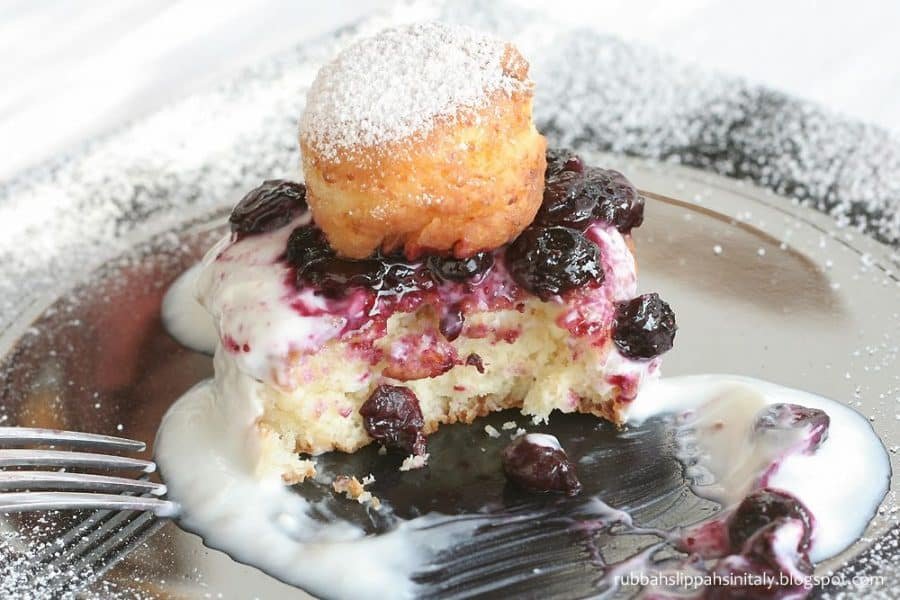
When in Cluj-Napoca, Romania, you’ll have the opportunity to savor a variety of traditional food options in Romania. Here are some of the places to eat all the must-try foods in Cluj:
- Mămăligă cu Brânză și Smântână. A traditional Romanian dish, mămăligă is a cornmeal porridge similar to polenta, often served with brânză (cheese) and smântână (sour cream). It’s a comforting and hearty option
- Sarmale. These are pickled cabbage rolls stuffed with a flavorful mixture of minced meat (usually pork or beef), rice, and spices. They are often served with smântână
- Mici. Known as “Mititei,” these are small grilled sausages made from a blend of minced meat (typically a mix of beef and pork) seasoned with garlic, paprika, and other spices. They are a popular street food.
- Varză a la Cluj. This is a local specialty in Cluj, consisting of cabbage rolls filled with a mixture of minced meat, rice, and spices, simmered in a tomato-based sauce
- Ciorbă de Perișoare. A sour meatball soup, typically made with beef or pork and flavored with sour cream and herbs
- Papanași. A delicious Romanian dessert, papanași are fried or boiled dumplings made from cottage cheese, covered with sour cream and fruit preserves. They are a sweet treat worth trying.
- Țuică: This is a traditional Romanian plum brandy, a strong alcoholic beverage often served as an aperitif or alongside meals
- Local Pastries. Explore local bakeries for a variety of pastries and desserts, such as cozonac (sweet bread), plăcinte (pastries filled with cheese, apples, or other ingredients), and clătite (pancakes) served with various fillings
To experience the full range of flavors in Cluj, consider dining at local restaurants, exploring street food vendors, and trying dishes that showcase Romania’s rich culinary traditions.
How To Get To Cluj-Napoca
Getting to Cluj-Napoca, a major city in Romania’s Transylvania region, can be done via several modes of transportation, depending on your starting location and preferences:
By Air
Avram Iancu Cluj International Airport (CLJ) is the main gateway for international and domestic flights. The Cluj-Napoca airport is well-connected with major cities across Europe through regular flights operated by various airlines, including low-cost carriers. From the airport, you can take a taxi or bus, or rent a car to reach the city center, approximately 10 km away.
By Train
To reach Cluj-Napoca by train, you can start in Bucharest (the capital), as well as other major cities in Romania and some neighboring countries. The train station is centrally located, and trains offer a scenic, albeit slower, mode of reaching the city.
By Bus
Numerous bus companies operate services to Cluj-Napoca from Romanian cities and various European destinations. Buses usually terminate at the central bus stations, which are conveniently located within the city.
By Car
If you’re coming from within Romania or neighboring countries, driving to Cluj-Napoca is a viable option. The city is accessible via major highways and roads. The A3 motorway connects Cluj-Napoca with Bucharest and other parts of the country, offering a fast and convenient route for drivers.
Move This Adventure To Your Inbox & Get An Instant Freebie

No spam. Unsubscribe at any time.
Where To Stay In Cluj
Accommodation in Cluj Napoca is varied and inexpensive; here are just a few suggestions to get you started.
Luxury Nook
Location: City center.
Why book: Tastefully decorated apartment, centrally located, air-conditioning, high-speed wifi, and is one the best places for affordable luxury. Check out the hotel & prices here ↳
Hotel Platinia
Location: Near Ursus Brewery, Central Park, and Cluj Arena.
Why book: Five-star luxury, well-equipped rooms with free wifi, hardwood floors, comfortable fabrics, walk-in showers, dressing room, sofa, television, and prime location near attractions. Check out the hotel & prices here ↳
Villa-Hotel Escala
Location: In a residential area.
Why book: Warm and welcoming owners, large air-conditioned rooms, quiet garden with a pool, and useful information from the owners, it’s a lovely place. Check out the hotel & prices here ↳
Sungarden Golf & Spa Resort
Location: Countryside.
Why book: Outdoor pool, sauna, relaxation room, Turkish bath, 9-hole golf course, outdoor bars, spacious rooms with luxury amenities, and private terrace. Check out the hotel & prices here ↳
Apartment Vintige
Location: In the heart of Cluj.
Why book: Close proximity to St. Michael’s Church and cafes, beautifully decorated apartment, and complimentary bike for easy exploration. Check out the hotel & prices here ↳
Garden City Apartment
Location: A little further out of town.
Why book: Ridiculously cheap residential apartment with a quiet garden and fully-equipped kitchen. Check out the hotel & prices here ↳
FAQs About Visting Cluj Napoca
What landmarks can I visit in Cluj, Romania?
Notable attractions include Parcul Cetátuia for its beautiful city views, the Romanian National Opera House for a rich cultural experience, and St. Michael’s Church for its historic significance.
What outdoor activities are there in Cluj?
Outdoor activities in Cluj are plentiful, including visiting the Botanical Garden, attending a CFR Cluj football game, and participating in several walking tours.
What food is unique to Cluj?
A local delicacy that you must try is “papanași”, which are Romanian doughnuts.
Can I take a day trip from Cluj?
Yes, there are numerous day trip options, which include visiting the Turda Salt Mine and exploring the Apuseni Mountains.
Can I experience art and cultural events in Cluj?
Indeed. Cluj hosts numerous music and art festivals and is home to the Bánffy Palace Museum of Art.
Where can I shop for souvenirs in Cluj?
The local market in Cluj is a great place for souvenir shopping, where you can find traditional items like Romanian embroidered shirts.
We hope this Cluj-Napoca guide filled with things to do around Cluj has given you the proper information to plan your visit to this hidden gem in Romania!
Initially written by Sean Lau of LivingOutLau and updated by the Chasing the Donkey team.

